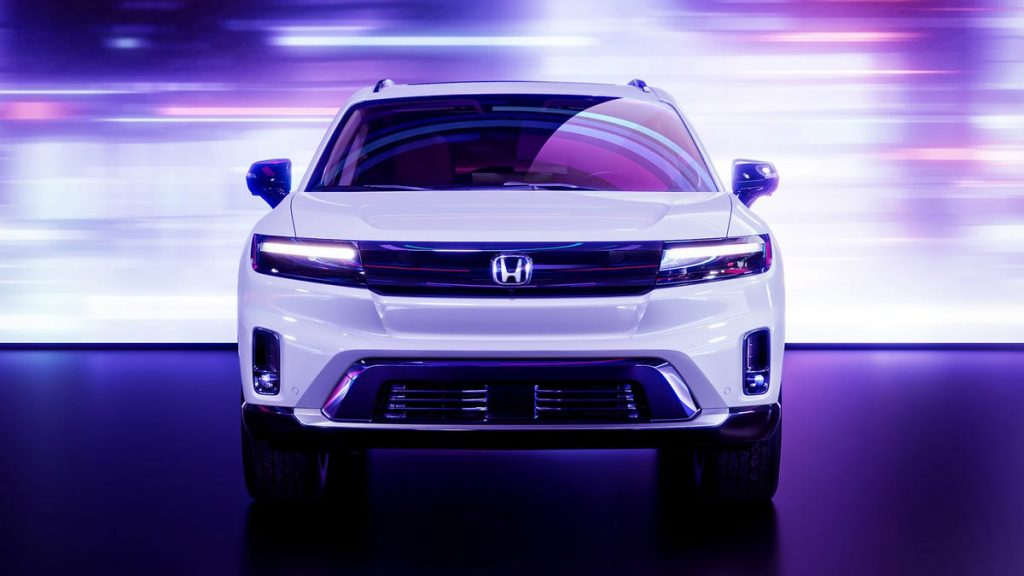Honda Can't Help the 2024 Prologue From Driving a Lot Like GM's Electric SUVs

Image: Honda
Don’t expect the battery-electric 2024 Honda Prologue, built using General Motors’ Ultium architecture, to offer a driving experience appreciably different from that of GM EVs. That’s what Honda’s own top brass told the media at a recent roundtable about the upcoming SUV.
Honda Senior Managing Executive Officer Shinji Aoyama seemed candid about the Prologue’s struggle to stand apart in terms of on-road dynamics. “We are limited due to the base architecture,” he was quoted telling journalists, per Motor1. “To differentiate [them] in terms of performance will be difficult.”
Instead, the secret sauce — if you can call it that — will be in the Prologue’s looks and what your hands touch. That’s what the company is counting on to make it feel like a Honda. “The design — the top hat — is where we will make our differentiation,” brand CEO and President Toshihiro Mibe added.
The honesty is somewhat refreshing to hear from industry players, as carmakers have a habit of embellishing the behavioral differences of two cars that bear a common provenance. Take the GR86 and BRZ, for example — a pair of rear-wheel-drive sport coupes that are much more similar than they are unique, in spite of Toyota and Subaru’s respective preferences in suspension tuning. Yeah, the GR86 is a little more tail happy and the Subaru is a little more balanced, but having driven both, the gulf is hardly as profound as either would like you to believe.
Of course, the Prologue being an SUV, its predisposition for spirited driving is less critical. Range and charging time are the type of performance metrics that matter here. It’s not surprising that the Prologue figures to be quite similar to a Blazer or Equinox EV behind the wheel, excusing packaging differences. It’s just a little surprising that Honda is readily admitting as much so early on.
G/O Media may get a commission
Wear your fandom on your sleeve.
MobyFox’s officially-licensed bands and custom watch faces are homages to fandoms spanning decades—from The Beatles, to Black Panther.
This was a necessary tradeoff, however, for Honda to throw its “top hat,” as it were, into the EV realm here in North America. Electing to run with GM’s Ultium floorplan will allow Honda to have an electric SUV on the market while it keeps cracking away at its own e:Architecture that will eventually power all of its cars. Since e:Architecture won’t ship in a Honda until 2026, the automaker needs a two-year stopgap. The Prologue, along with its Acura counterpart, will provide that stopgap.
Better yet, thanks to the legwork GM has already put in to base its EV and battery manufacturing for North America in North America, both SUVs should qualify for the full $7,500 federal tax credit under the Inflation Reduction Act. That probably won’t be true of all the Prologue’s competitors — at least, not when it goes on sale.
The interior of the 2024 Honda PrologueImage: Honda
But could the Prologue’s design really make it unique enough from the GM set? From the outside, the Prologue doesn’t look like a Chevy product. (I reckon that’s a good thing, but to each their own.) From the inside, the line appears to blur somewhat.
The interior of the 2023 Chevrolet Blazer EVImage: General Motors
The Prologue’s steering wheel — particularly the left and right spokes, as well as the buttons they contain — is clearly lifted from what you’ll find in the Blazer and Equinox EVs. So too are its interior door handles and associated lock buttons. I’d expect the resemblance to bleed into the software and infotainment side of things; it’s all intertwined with EVs anyway, isn’t it. But, again, we should have clearer answers in about a year and change.



